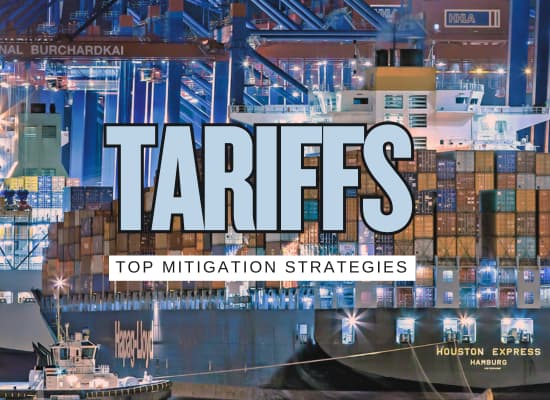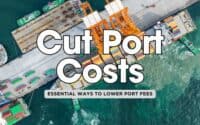15 Powerful Ways to Cut Tariff Costs in Global Shipping

As of 2025, the global maritime industry is navigating a volatile wave of newly imposed tariffs. The United States has expanded tariffs to include a wide range of countries and product categories, prompting serious concern among shipowners, freight forwarders, and global logistics operators. From steel to semiconductors, goods moving by sea are now subject to rising costs—forcing the industry to rethink its pricing models, sourcing routes, and customs strategies. In this evolving landscape, knowing how to mitigate tariff costs isn’t just helpful—it’s essential for staying competitive. Below, we dive into 15 expert-backed strategies to help reduce or offset the financial impact of global tariffs, starting with one of the most powerful yet underutilized tactics in the shipping world today.

We welcome your feedback, suggestions, corrections, and ideas for enhancements. Please click here to get in touch.
One of the most overlooked yet powerful ways to reduce tariff costs is by lowering the dutiable value of imported goods. The U.S. "First Sale Rule" allows importers to base their customs value on the price of the first sale in a multi-tiered transaction — often lower than the final resale price. When properly documented, this can translate into significant savings on import duties.
✅ Benefits:- Reduces declared customs value, lowering tariff costs.
- Legal and approved by U.S. Customs (with proper documentation).
- Works especially well for businesses using overseas intermediaries.
- Requires proof that the first sale was intended for export to the U.S.
- Can trigger customs audits if not documented carefully.
- Not valid if the intermediary alters or takes ownership of the goods.
- Brands sourcing through offshore trading companies or agents.
- Shipments involving multiple tiers in the supply chain.
- Industries like apparel, electronics, and tools with layered sourcing models.
- Remains a compliant and cost-effective tactic in 2025.
- Use may grow as tariffs broaden globally.
- Could face future restrictions depending on trade policy shifts.
- Work closely with your customs broker to structure contracts that qualify for the first sale rule.
- Ensure clear documentation: original invoices, purchase orders, and proof of export intent are essential.
Foreign Trade Zones (FTZs) are secure, government-designated locations where goods can be imported without immediately triggering U.S. tariffs. Duties are paid only when the goods leave the FTZ for domestic consumption — or not at all if they’re re-exported. For shippers dealing with unpredictable tariffs or complex global flows, FTZs offer a powerful buffer.
✅ Benefits:- Tariff payments are deferred until the goods leave the FTZ.
- Products re-exported from the FTZ avoid U.S. tariffs entirely.
- Helps manage cash flow and reduce customs processing fees.
- Requires FTZ approval and facility setup (can take months).
- Strict inventory tracking and compliance are mandatory.
- Best suited for high-volume or frequently imported goods.
- Importers bringing in goods that may be re-exported later.
- Companies managing fluctuating inventory or long storage times.
- Businesses importing components for delayed assembly or distribution.
- Increased interest due to rising tariffs and regulatory complexity.
- More logistics providers are offering shared FTZ space to speed up adoption.
- Will remain a go-to strategy for tariff deferral and flexibility.
- If you’re not ready to operate your own FTZ, consider using a 3PL that offers shared FTZ facilities.
- Use FTZs to manage tariff risk while awaiting policy changes or supply chain decisions.
Tariff classification under the Harmonized Tariff Schedule (HTS) can have a massive impact on duty rates. By lawfully reclassifying goods or adjusting product design to qualify for a lower-duty code, companies can significantly reduce import costs. This practice, known as “tariff engineering,” is legal when done transparently and backed by documentation.
✅ Benefits:- Legally reduces duty rate without changing country of origin.
- Gives businesses more control over landed costs.
- Can be applied proactively at the product development stage.
- Requires deep knowledge of the HTS and its rulings.
- Changes must be legitimate — cosmetic or deceptive tweaks can lead to penalties.
- Engineering costs may outweigh tariff savings in some cases.
- Apparel, electronics, tools, and machinery with multiple possible classifications.
- Products assembled or finished just before export.
- Firms with in-house or outsourced product design flexibility.
- Widely used by top importers — will continue as tariffs evolve.
- Customs agencies are increasingly scrutinizing classifications, so documentation is key.
- May become more relevant if tariffs extend to new sectors or product types.
- Partner with a customs attorney or trade specialist to review HTS options.
- Review product designs annually to ensure they still align with the most favorable classification.
When tariffs strike specific countries, relocating production or sourcing to alternative regions can reduce or eliminate duty exposure. Many companies are already adopting “China+1” strategies or nearshoring to Latin America and Southeast Asia. This shift is not always easy—but it’s often one of the most effective long-term plays for tariff resilience.
✅ Benefits:- Can immediately lower or eliminate country-specific tariffs.
- Reduces dependence on one manufacturing region.
- Often improves lead times and shipping flexibility.
- Relocation can be costly and time-consuming.
- New suppliers may require vetting, audits, and ramp-up time.
- Quality control, capacity, and IP protection can vary by region.
- Products with high duty rates in origin country.
- Businesses with enough volume to justify supplier diversification.
- Industries like apparel, electronics, and machinery with flexible sourcing models.
- Supply chain diversification will continue to accelerate in response to tariffs and geopolitical risks.
- More firms are adopting “multi-country sourcing” models to hedge risk.
- Governments may offer incentives to relocate production out of tariffed zones.
- Start by qualifying a second-source supplier in a lower-tariff country—even if just for partial volume.
- Use tariff forecasts and FTA comparisons to guide regional moves.
One way to buffer against tariff volatility is by locking in pricing with your suppliers and carriers. Long-term contracts can stabilize landed costs, secure capacity, and sometimes shift or share tariff-related risks. This strategy helps companies avoid surprise cost spikes caused by sudden policy changes or supply chain disruptions.
✅ Benefits:- Provides pricing stability in an unpredictable tariff environment.
- May allow for tariff cost-sharing with suppliers.
- Helps avoid spot market surges during high-demand periods.
- Requires strong supplier relationships and negotiation leverage.
- Locked pricing may backfire if tariffs are later reduced.
- Contract complexity increases if tariff clauses are included.
- High-volume importers with repeat orders and stable SKUs.
- Shippers operating in high-tariff categories (e.g., metals, electronics).
- Businesses with limited ability to adjust pricing downstream.
- Tariff-sharing clauses are becoming more common in 2025 contracts.
- Freight forwarders and carriers may offer multi-year deals with risk adjustments.
- Contract flexibility will be key as global tariffs evolve.
- Include specific language about tariff responsibility and cost passthroughs.
- Review all long-term contracts annually for tariff relevance and risk-sharing terms.
Many importers overlook legal programs that offer partial or full duty relief. These include de minimis exemptions (Section 321), Temporary Importation under Bond (TIB), and other country- or product-specific exclusions. When used strategically, these programs can eliminate tariffs on qualifying shipments, reduce cash outflows, and add flexibility to supply chains.
✅ Benefits:- Allows goods to enter duty-free or at reduced rates.
- Can significantly lower import costs for certain product categories.
- Offers flexibility for re-exports, samples, repairs, or temporary uses.
- Strict qualification rules and documentation requirements.
- Programs like de minimis may be limited by country of origin.
- Compliance errors can lead to retroactive duties or penalties.
- Low-value shipments eligible for Section 321 ($800 or less).
- Goods imported temporarily (for exhibitions, testing, or repair).
- Products that qualify for special U.S. exemptions or exclusions.
- Programs may face tighter rules as countries crack down on misuse.
- Still highly valuable when applied properly with strong compliance.
- More logistics providers are helping shippers tap into these programs.
- Work with a customs broker to identify exemptions specific to your products and countries of origin.
- Consider combining this with bonded storage or FTZ strategies for greater flexibility.
Tariff drawback programs allow importers to reclaim up to 99% of duties paid on goods that are later exported. Whether you're re-exporting raw materials, components, or finished products, this is a powerful way to recover costs—especially when dealing with high-tariff categories like metals, apparel, and electronics.
✅ Benefits:- Can recover nearly all paid duties on qualifying exports.
- Boosts profitability on international sales and distribution.
- Applies to both unused goods and items that are further manufactured.
- Requires detailed tracking and matching of imports to exports.
- Filing process can be complex and time-consuming.
- Claims must typically be submitted within five years of import.
- Companies that import goods and later export them unchanged or modified.
- High-volume exporters with centralized distribution hubs.
- Industries like apparel, machinery, and aerospace.
- Use of drawback filings is increasing as tariffs rise globally.
- Digital customs systems are making claims easier to process.
- Expected to remain a cornerstone of tariff recovery strategy.
- Partner with a drawback specialist or trade attorney to maximize claims.
- Keep tight records of import dates, product SKUs, and export paperwork to support audits.
Bonded warehouses allow imported goods to be stored without paying duties until they’re formally entered into U.S. commerce. If the goods are re-exported directly from the warehouse, no duties are owed at all. This gives businesses time to make decisions about distribution, re-export, or even destruction—without triggering tariff costs upfront.
✅ Benefits:- Delays or avoids tariff payments on incoming goods.
- Goods can be stored for up to five years without duty.
- Ideal for re-exporters or companies awaiting regulatory clearance.
- Requires customs approval and ongoing compliance reporting.
- Not all ports or facilities offer bonded storage.
- Storage fees can add up if turnover is slow.
- Importers unsure whether goods will enter the U.S. market or be re-exported.
- Companies dealing with seasonal products or regulatory delays.
- Traders or manufacturers holding inventory near major ports.
- Bonded warehousing is becoming more popular due to broader tariffs.
- New bonded logistics parks are opening in key U.S. and EU gateways.
- Expect tighter digital inventory tracking regulations in the near future.
- Combine bonded warehousing with drawback or FTZ strategies for even more tariff flexibility.
- Ensure full visibility of warehouse movements to avoid customs penalties or misfilings.
With tariffs evolving fast and trade compliance rules getting more complex, working closely with experienced customs brokers or trade consultants can save you time, money, and legal risk. These professionals can help you uncover tariff-saving opportunities, avoid costly mistakes, and ensure your filings are audit-proof.
✅ Benefits:- Accurate product classification and duty optimization.
- Access to insider programs like duty deferral, FTZ, and drawback.
- Reduces risk of fines, shipment delays, or customs holds.
- Expert support comes with added cost — but usually pays for itself.
- Not all brokers specialize in tariff mitigation or complex strategies.
- Requires clear communication and alignment on compliance goals.
- Businesses importing large volumes or operating across multiple countries.
- Companies with high-tariff exposure or uncertain product classifications.
- Firms implementing new strategies like First Sale or reclassification.
- Demand for trade advisory services is rising rapidly.
- Digital compliance tools are increasingly paired with human experts.
- Expect tighter enforcement, making professional oversight even more valuable.
- Choose a broker who understands your industry and offers proactive advice — not just paperwork.
- Consider bundling brokerage with digital tools for real-time tariff tracking and compliance alerts.
Incoterms define who is responsible for shipping, insurance, and customs costs during international transactions. By renegotiating Incoterms—such as switching from FOB (Free on Board) to DDP (Delivered Duty Paid)—companies can shift tariff responsibility to the party better equipped to handle or absorb those costs. This can be a strategic way to share the tariff burden with suppliers or customers.
✅ Benefits:- Clarifies who pays duties, taxes, and fees at import.
- Can shift tariff exposure to a supplier or buyer based on leverage.
- Enables cost-sharing or pricing adjustments in contract terms.
- Requires strong negotiation and mutual understanding between parties.
- Not always possible if supplier terms are fixed or inflexible.
- Legal contracts must be updated to reflect changes in risk and responsibility.
- Established relationships where trust and volume can drive renegotiation.
- Businesses importing from countries hit with sudden tariffs.
- Exporters who want to simplify the landed cost for overseas customers.
- Incoterm flexibility is increasingly seen as a tariff management tool.
- More businesses are revisiting international contract structures in 2025.
- May become standard practice in long-term global supply agreements.
- Work with legal and procurement teams to align Incoterms with your cost-control strategy.
- Ensure Incoterms match actual logistics flows to avoid miscommunication and liability gaps.
By consolidating multiple shipments into a single customs entry—or spreading them across different dates depending on duty thresholds—importers can reduce administrative costs and even lower tariffs. This tactic, often coordinated with freight forwarders or customs brokers, can help avoid unnecessary charges and optimize customs declarations.
✅ Benefits:- Reduces per-entry fees and processing time.
- Can take advantage of de minimis thresholds or lower-duty brackets.
- Improves efficiency across documentation and inspections.
- Requires close coordination of shipment timing and volume.
- May cause delays if bundled shipments aren’t ready simultaneously.
- Complex when working with multiple suppliers or varying product types.
- Importers with predictable volumes and frequent smaller shipments.
- eCommerce operations shipping to fulfillment centers.
- Companies aiming to minimize per-shipment overhead.
- More digital brokers are offering shipment optimization tools.
- Smart bundling will become a key compliance strategy in high-tariff environments.
- Expect customs systems to automate and flag bundling opportunities in the future.
- Use your broker’s software or EDI platform to flag shipments that can be combined or split.
- Keep tabs on entry thresholds—some countries waive duties under certain invoice values or shipment weights.
Free Trade Agreements (FTAs) are powerful tools that can eliminate or reduce tariffs between participating countries. By aligning your sourcing or distribution with FTA-covered nations—and properly documenting country of origin—you can legally bypass some of the steepest import duties. Examples include USMCA, EU FTAs, ASEAN agreements, and more.
✅ Benefits:- Legally reduces or eliminates duties for eligible goods.
- Improves price competitiveness in global markets.
- Often speeds up customs clearance due to standardized treatment.
- Strict rules of origin must be met and documented.
- Incorrect or missing FTA certificates can lead to penalties or delays.
- Agreements vary significantly by country and product type.
- Products with clear and traceable manufacturing origins.
- Companies importing from or exporting to countries with active FTAs.
- Shippers looking to reduce duty exposure on recurring trade lanes.
- More companies are reviewing sourcing to align with FTAs in 2025.
- FTAs are expanding, especially in Asia-Pacific and Latin America.
- Digital FTA compliance platforms are streamlining documentation.
- Conduct a product-by-product audit to identify FTA eligibility and documentation gaps.
- Make sure suppliers can certify country of origin and provide valid documentation to support your claims.
Relying on a single country or supplier for critical materials can backfire when tariffs hit unexpectedly. By spreading your sourcing across multiple regions, you can reduce your exposure to country-specific duties and political disruptions. Diversification also gives you leverage in negotiations and more options when reacting to policy shifts.
✅ Benefits:- Reduces the impact of tariffs tied to specific countries.
- Builds resilience against supply chain disruptions or sanctions.
- Improves negotiating power with existing suppliers.
- Onboarding new suppliers takes time and resources.
- Managing quality and consistency across regions can be difficult.
- May involve increased logistics complexity and cost at first.
- Companies heavily reliant on Chinese, Indian, or tariff-heavy origins.
- Importers with flexibility to test alternate sourcing markets.
- Firms interested in exploring nearshoring or “China +1” strategies.
- Tariff trends and geopolitical uncertainty are accelerating diversification efforts.
- Global buyers are increasingly looking to Southeast Asia, Latin America, and Eastern Europe.
- Technology is helping businesses vet and manage suppliers globally.
- Start by identifying key SKUs that represent tariff risk and test-sourcing from alternate regions.
- Use supplier databases and trade intelligence tools to evaluate new sources quickly.
Rushed shipments caused by poor forecasting or last-minute inventory gaps often lead to higher freight rates, missed tariff exemptions, and rushed customs filings—each adding cost. By tightening your supply chain planning and using better forecasting tools, you can avoid reactive shipping and reduce the financial impact of tariffs and related surcharges.
✅ Benefits:- Reduces exposure to expedited shipping and premium freight costs.
- Allows time to plan tariff-friendly routes and classifications.
- Improves inventory stability and customer delivery performance.
- Requires strong internal coordination between procurement, logistics, and sales.
- Demand forecasting must be accurate to be effective.
- Unexpected market disruptions can still throw off plans.
- Businesses frequently using air freight or incurring rush costs.
- Companies managing long lead times or seasonally sensitive inventory.
- Firms seeking to optimize logistics alongside tariff strategy.
- AI-powered demand planning is becoming a key tool for tariff-conscious importers.
- Integrated ERP and logistics platforms are helping connect planning to customs strategy.
- Expect proactive planning to become a differentiator in cost efficiency.
- Align procurement and logistics calendars to avoid last-minute decisions that spike costs.
- Build in buffer stock or lead times when dealing with high-duty product categories.
Manual customs tracking and spreadsheet-based compliance can’t keep up with modern tariff shifts. Digital trade tools help automate tariff classification, track regulatory changes, flag savings opportunities, and ensure accurate filings. These platforms can also integrate with ERPs, improving visibility from purchase order to final delivery.
✅ Benefits:- Reduces errors in customs classification and documentation.
- Helps identify duty-saving strategies in real time.
- Improves audit readiness and regulatory compliance.
- Requires initial investment and employee training.
- Integration with legacy systems may be complex.
- Ongoing updates needed as trade rules evolve.
- High-volume importers managing multiple SKUs and trade lanes.
- Companies with complex product classification needs.
- Firms subject to audits or heavy documentation requirements.
- AI-powered compliance is becoming standard in large-scale operations.
- Smaller importers are increasingly adopting subscription-based platforms.
- Expect future trade platforms to automate duty forecasting and classification suggestions.
- Evaluate tools like Avalara, Descartes, or WiseTech Global for customs automation.
- Use these platforms not just for compliance, but to surface savings and avoid delays.
In today’s high-stakes trade environment, global shippers can no longer afford to treat tariffs as a passive cost of doing business. With sweeping tariff expansions making headlines and reshaping logistics flows, the ability to actively manage and reduce duty exposure is now a competitive advantage.
The 15 strategies covered here—from tactical tools like First Sale and FTZs to big-picture plays like supplier diversification and digital compliance—represent a modern playbook for navigating trade disruptions with confidence. No single solution fits all, but when combined and tailored to your operation, these tactics can dramatically cut costs, boost flexibility, and protect margins in uncertain times.
Now is the time for shipping and logistics teams to take a proactive stance. Whether you're moving container loads of electronics or bulk commodities, building a tariff-resilient supply chain is no longer optional—it's essential. Revisit your sourcing, contracts, customs processes, and technology stack. Small moves now can mean massive savings later.
Table Summary
| 15 Powerful Ways to Cut Tariff Costs in Global Shipping | ||
| Strategy | Description | Importance |
| 1. First Sale Rule | Declare the cost of the first transaction in a multi-tier supply chain as the customs value to lower duties. | Reduces duty base price legally—great for layered sourcing setups like apparel, tools, or electronics. |
| 2. Foreign Trade Zones (FTZs) | Store goods duty-free in designated zones until released for domestic consumption—or re-exported tariff-free. | Delays or eliminates duties and adds flexibility for businesses unsure where goods will end up. |
| 3. Tariff Engineering | Redesign or reclassify products to legally qualify for lower-duty codes in the Harmonized Tariff Schedule. | Common in manufacturing. Can lower rates dramatically if done correctly with proper support docs. |
| 4. Shift Sourcing Locations | Move production away from high-tariff countries to regions with lower or no duties. | The “China +1” model helps companies adapt and reduce long-term duty risk from geopolitics. |
| 5. Long-Term Contracts | Negotiate stable pricing and tariff responsibility in supplier and carrier contracts. | Protects against unexpected price hikes and allows clearer cost planning even as tariffs rise. |
| 6. Use Special Import Programs | Tap into de minimis, exemptions, or Temporary Importation under Bond (TIB) to avoid or delay duties. | Great for low-value shipments or goods that are re-exported, displayed, or temporarily used. |
| 7. Duty Drawbacks | Recover up to 99% of paid tariffs on goods that are later re-exported. | Huge savings for companies doing U.S. imports and then shipping internationally again. |
| 8. Bonded Warehousing | Store goods in a customs-bonded warehouse without paying duties until they're sold domestically. | Lets you delay or avoid duties altogether if items are re-exported—ideal for flexible global distribution. |
| 9. Work With Trade Experts | Use customs brokers or trade consultants to ensure proper classification, exemptions, and compliance. | Saves time, avoids errors, and helps unlock hidden duty reduction opportunities most teams miss. |
| 10. Adjust Incoterms | Renegotiate Incoterms to shift tariff responsibility to the buyer or seller depending on leverage. | You can offload duty risk or negotiate who pays tariffs upfront in your international contracts. |
| 11. Bundle or Time Shipments | Group shipments together or time their entry to optimize cost thresholds and customs entries. | Reduces per-entry costs and can help keep you under duty limits—especially for small packages. |
| 12. Use Free Trade Agreements | Qualify goods under FTAs like USMCA or ASEAN to eliminate or reduce duties entirely. | Massive savings potential if origin rules are met and documentation is in place—ideal for strategic sourcing. |
| 13. Diversify Supplier Base | Avoid overreliance on a single country by spreading sourcing across multiple regions. | Reduces exposure to sudden country-specific tariffs and builds resilience in volatile trade environments. |
| 14. Improve Planning to Avoid Expedited Costs | Use better forecasting and logistics planning to avoid rush shipping and reactive decisions. | Prevents last-minute shipments that blow budgets and miss tariff-saving opportunities. |
| 15. Invest in Digital Compliance Tools | Use software to automate classification, monitor duty changes, and streamline filings. | Saves money, avoids compliance errors, and helps teams stay ahead of fast-changing tariff rules. |

Do you have a Maritime Product or Service that may be of interest to Shipowners? Tell us about it here!
Do you have feedback or insights? Please reach out to editor @ shipuniverse.com



